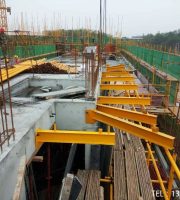3) The wall connecting parts should be set close to the main node, and the distance from the main node should not be more than 300 mm
. 
5) The width of scaffold bottom support shall not be less than 100 mm and the thickness shall not be less than 5 mm
. 
2) The vertical deviation of the vertical pole shall be implemented according to the data in table 8.2.4 of the technical specification jgj130-2011
. 
The scaffold bearing the building must be accepted according to the calculation requirements
. 
When is scaffold acceptance required? The scaffold should be accepted in the following stages: 1) after the foundation is completed, before the scaffold is erected
. 
Fasteners with cracks must never be used in the frame
. 
The spacing of the horizontal bar shall be set up according to the use of the scaffold
. 
In double pole scaffold, the height of auxiliary pole shall not be less than 3 steps, and the length of steel pipe shall not be less than 6m
. 
3) The thickness of the base plate at the bottom of the scaffold more than 24m must be strictly calculated
. 
3) When scaffold board is used, both ends of horizontal bar of double row scaffold shall be fixed on vertical bar with right angle fastener
. 
➤ error example} not setting the sweeping pole} the horizontal sweeping pole is not fixed with the vertical pole ➤ correct example 5 main body ➤ acceptance content 1) the main body acceptance of the scaffold is calculated according to the construction needs, such as the installation of ordinary scaffold, the vertical pole spacing must be less than 2m, the longitudinal horizontal pole spacing must be less than 1.8m, and the vertical horizontal pole spacing must be less than 2m
. 
When the scaffold board is butt laid, two horizontal bars must be set at the joint, and the external extension of the scaffold board shall be 130-150 mm, and the sum of the extension length of the two scaffold boards shall not be greater than 300 mm; when the scaffold board is overlapped, the joint must be supported on the horizontal bar, and the overlapping length shall be greater than 200 mm, and the length of the two scaffold boards extending out of the horizontal bar shall not be less than 100 mm
. 
2) The setting distance of drainage ditch should be more than 500mm from the outermost vertical pole of scaffold
. 
Source: the copyright of Luban union of network and construction engineering belongs to the original author
. 
4) The scaffold bottom support must be placed in the center of the base plate
. 
When it is on the operation floor, a small cross bar should be added between the two nodes to bear and transfer the load on the scaffold board
. 
5) In the process of frame erection, fasteners must be used reasonably, and can not be substituted or misused
. 
4) Whether there is water in the scaffold foundation and foundation
. 
3) The longitudinal sweeping pole shall be fixed on the vertical pole not more than 200 mm away from the base with right angle fasteners
. 
The three kinds of scaffold boards can be laid by butt joint or lap joint
. 
2) The horizontal height difference of the sweeping pole shall not be greater than 1m, and the distance from the slope shall not be less than 0.5m
. 
➤ error example ➤ correct example 2 drainage ditch ➤ acceptance content 1) remove and level the debris in the scaffold erection site, and make the drainage unobstructed
. 
5) After reaching the design height (each layer of scaffold for structural construction shall be accepted once)
. 
➤ error examples} unqualified fasteners} unqualified fasteners} large spacing of vertical poles and irregular setting of cross bracing} the overall sinking and deformation of scaffold due to weak scaffold rooting} bending of vertical pole} correct examples 6 scaffold board ➤ acceptance content 1) scaffold board must be fully paved after scaffold erection on construction site, and scaffold board must be correctly butted, and scaffold board shall be staggered at the corner of scaffold Lap, and must be tied, uneven with wooden block pad nail firm
. 
3) After the erection of 6-8m height
. 
➤ error examples} cracks in the plate} moldy plate} the plate thickness does not reach 5cm} the scaffold board has gaps} the small cross bar spacing is large} the scaffold board is not fully paved, not tied, not equipped with protective railings} the end of the scaffold board is not blocked} the scaffold board is not fully paved, not tied ➤ correct examples} the scaffold board docking / overlapping structure 7 wall connecting parts ➤ acceptance content 1) there are two types of wall connecting parts: rigid The rigid wall connecting parts should be used in the construction site
. 
5) Both ends of the scaffold must be equipped with wall connecting pieces, and the vertical spacing of wall connecting pieces shall not be greater than the floor height of the building, and shall not be greater than 4m (two steps).
. 
4) The wall connecting parts should be arranged in diamond shape, square shape and distance shape
. 
➤ error examples ➤ correct examples 3 base plate and bottom bracket ➤ acceptance content 1) the acceptance of base plate and bottom bracket of scaffold is determined according to the height and bearing capacity of scaffold
. 
The small cross bar must be fixed on the longitudinal horizontal bar with right angle fasteners
. 
3) Whether the scaffold foundation and foundation are smooth
. 
4) The small cross bar of scaffold should be set at the intersection of the vertical bar and the large cross bar, and it must be connected with the vertical bar with right angle fasteners
. 
10 items of scaffold acceptance 1
. 
2) The wall connecting parts shall be set from the first longitudinal horizontal bar at the bottom of the scaffold
. 
The probe length of the scaffold board at the end of 120-150 mm away from the wall shall not be more than 200 mm
. 
4) A water collecting well (600mm × 600mm × 1200mm) should be set at the end of the ditch to ensure that the water in the ditch is discharged in time
. 
3) In addition to the lap joint at the top of the top layer, butt fasteners must be used to connect the joints of other layers when the scaffold pole is lengthened
. 
2) Whether the scaffold foundation and foundation are compacted
. 
4) One end of the horizontal bar of single row scaffold shall be fixed on the vertical bar with right angle fastener, and the other end shall be inserted into the wall, and the insertion length shall not be less than 18cm
. 
Foundation and foundation ➤ acceptance 1) whether the construction of scaffold foundation and foundation has been calculated according to the height of scaffold erection and the soil condition of erection site according to relevant regulations
. 
5) The scaffold board of operation layer shall be fully and stably paved, 12cm ~ 15cm away from the wall
. 
6) In case of force 6 or above wind or heavy rain, the frozen area will be thawed
. 
6) When the length of the scaffold board is less than 2m, it can be supported by two horizontal bars, but the two ends of the scaffold board should be fixed to it reliably to prevent tipping
. 
For scaffolds with height between 24m and 50m, the wall connecting parts should be set in two steps and three spans
. 
This video interprets the key points of safe construction technology of scaffold operation in detail from the following seven aspects, which are worth learning: ① safety management requirements of scaffold operation; ② construction preparation; ③ basic requirements of floor type scaffold erection; ④ basic requirements of section steel cantilever scaffold erection; ⑤ full hall scaffold erection Basic requirements; 6) inspection and acceptance; 7) basic requirements for scaffold removal
. 
For scaffolds with height less than 24m, the wall connecting parts should be set in three steps and three spans
. 
2) The scaffold board of the operation layer shall be smooth, full and tightly packed, and firmly bound
. 
2) The specification of the base plate of the scaffold below 24m is (the width is greater than 200 mm, the thickness is greater than 50 mm, and the length should not be less than 2 cm), and each vertical pole must be placed in the middle of the base plate, and the base plate area shall not be less than 0.15 m2
. 
7) It has been out of service for more than one month
. 
2) The first step of large and medium-sized scaffolds is after the erection of large cross bar
. 
The scaffold board can be laid either by butt joint or by lap joint
.
8) Before removal
.
➤ error example ➤ correct example 4 sweeping pole ➤ acceptance content 1) the sweeping pole must be connected with the vertical pole, not between the sweeping pole and the sweeping pole
.
The joints of the scaffold body should be staggered: the joints of two adjacent poles should not be set in the same span or in the same synchronization; the horizontal staggering distance of two adjacent joints in different spans should not be less than 500mm; the distance between the center of each joint and the nearest main node should not be less than 500mm The distance should not be greater than 1 / 3 of the longitudinal distance; the lap length should not be less than 1m, three rotating fasteners should be set at equal intervals for fixation, and the distance from the edge of the end fastener cover plate to the end of the lap longitudinal horizontal bar should not be less than 100 mm
.
3) The width of the drainage ditch is between 200 mm and 350 mm, and the depth is between 150 mm and 300 mm
.
4) Before the load is applied on the working face
.
4) The horizontal sweeping pole should be fixed on the vertical pole close to the bottom of the longitudinal sweeping pole with right angle fastener
.



